
#reviewandreflect: Mind Your Mental Map
 This is TheSchoolHouse302’s monthly #review&reflect, wrapping up our focus on 3 Ways to Get Ahead–Looking Beyond Your Shadow for Better Weather.
Our review and reflect series offers readers the opportunity to take a deep dive into our leadership content by taking time to reflect and identify the skills you need, to explore how you can learn those skills, and to connect with industry leaders to follow to gain greater expertise.
Skills I need…
This is TheSchoolHouse302’s monthly #review&reflect, wrapping up our focus on 3 Ways to Get Ahead–Looking Beyond Your Shadow for Better Weather.
Our review and reflect series offers readers the opportunity to take a deep dive into our leadership content by taking time to reflect and identify the skills you need, to explore how you can learn those skills, and to connect with industry leaders to follow to gain greater expertise.
Skills I need…
Our minds, the thoughts we hold, create our world, which is the perception that we have of ourselves, other people, and circumstances and situations. We call this our Mental Map. Because the average person has between 12,000 and 60,000 thoughts per day, with up to 95% of them repeating themselves, we need to be mindful of our self-talk, what we tell ourselves internally. And, considering that 95% of the thoughts we have at any given moment are occupying space that they have already occupied in the past 24 hours, we need our repeating record to play “music” that is empowering, encouraging, and enlivening. The question is: is your self-talk a good friend or deafening enemy?
Review: Eighty percent of our thoughts are negative, that’s a lot of unproductive time and energy. Negative thoughts are a liability for leaders, which we identify as “liability thinking.” To counter this downward thinking trend, and lead from a position of resourcefulness, we created a three-part behavior model to help you to be mindful of your mental map.
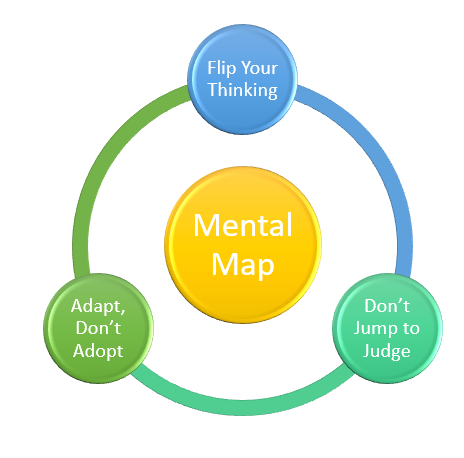
The model reminds us that have the ability to manage our thoughts and subsequent actions. It takes into consideration how we view ourselves and the world around us to that you can have the right mindset to lead better and grow faster. We do have the distinct freedom in life to turn obstacles into opportunities.
Reflect: The beauty of the Mental Map Model is that it serves as simple yet effective advice for leaders. The first stop on our map is to Flip Your Thinking, the second stop is a reminder, Don’t Jump to Judge, and the third spot helps us to quit abandoning practices and programs wholesale by learning to Adapt, Don’t Adopt.
Take 3 Minutes to reflect on your ability to mind your mental map.
- How often do you focus on what you don’t want instead of what you do want? For example, I don’t want to be overweight versus I want to lose 10 pounds in the next two months.
- How well do you collect pertinent information to gain clarity on a situation? For example, are the communication lines open for you to receive feedback on situations?
- How well do you adapt and grow, rather than prematurely abandoning programs? For example, do you connect the dots of various situations to strategically make the next move?
What should I read to strengthen my mind a create a powerful Mental Map?
Review: In our #readthisseries we featured the work of authors who clearly articulate the power of clear Mental Maps
Make it stick: The science of successful learning by Brown, Roediger, and McDaniel
The leadership gap: What gets between you and your greatness by Lolly Daskal
Thanks for the feedback: The science and art of receiving feedback well by Stone and Heen
You can’t miss our #readthisseries on 3 books you need to read for a stronger mental map.
Self Assessment:
Effective and productive leaders recognize the power of positive thinking and minding their mental map and the maps of those they lead. Based on the 3-part assessment, and using a 5-point scale, 1 being ineffective and 5 being highly effective, rate yourself:
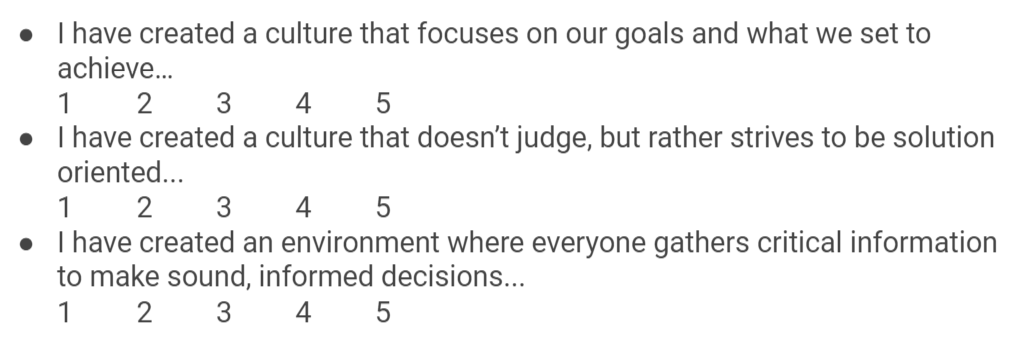
Based on the questions above, which aspect of the behavior Mental Map Model do you need to develop further?
Who should I follow…What does an expert have to say about understanding leadership and most importantly yourself.
Review: For our #onethingseries, we interviewed Lolly Daskal.
Action: Lolly eloquently describes how there are two competing sides, a polarity of character, within each of us that can lead us to greatness or completely derail our effectiveness. She advises us to not think about what we are doing but rather who we are being. Her advice on self-discovery as a leader is profound. So the question is, are you who you want to be?
Let us know!
Listen to the entire podcast on iTunes, One Thing Series, and please rate and like (it helps).
That’s our #review&reflect for Minding Your Mental Map–3 Ways to Get Ahead. Take a look back to take a step forward. TheSchoolHouse302 is about getting to simple and maximizing effective research-based strategies that empower individuals to lead better and grow faster. Please let us know how our leadership posts are working for you, what you are reading to improve yourself, and your thoughts on leadership and growth here on our blog and Twitter. Follow our #onethingseries podcast on iTunes and our #readthisseries on YouTube. Joe & T.J.
#readthisseries: 3 Books You Need to Read for a Clearer Mental Map

Don’t miss this vblog on books you need to read to lead better and grow faster. We recommend three titles that are must-reads on the topic of getting ahead with a clearer mental map. You can find our catalog of great leadership books at dereka206.sg-host.com — click on #readthisseries.
Brown, P., Roediger, H., & McDaniel, M. (2014). Make it stick: The science of successful learning. London: Harvard University Press.
Daskal, L. (2017). The leadership gap: What gets between you and your greatness. New York: Penguin.
Stone, D. & Heen, S. (2015). Thanks for the feedback: The science and art of receiving feedback well. New York: Penguin.
As always, please like, follow, and comment. If you have books that we should read and recommend, please let us know that as well.

#onethingseries: Understanding Your Leadership Gaps w/ Lolly Daskal, @LollyDaskal
Don’t miss this leadership interview with Lolly Daskal. Lolly Daskal is one of the most sought-after executive leadership coaches in the world. Her extensive cross-cultural expertise spans 14 countries, six languages, and hundreds of companies. As founder and CEO of Lead From Within, her proprietary leadership program is engineered to be a catalyst for leaders who want to enhance performance and make a meaningful difference in their companies, their lives, and the world.
Based on a mix of modern philosophy, science, and nearly thirty years coaching top executives, Lolly’s perspective on leadership continues to break new ground and produce exceptional results. Of her many awards and accolades, Lolly was designated a Top-50 Leadership and Management Expert by Inc Magazine. Her writing has appeared in HBR, Inc.com, Fast Company (Ask The Expert), Huffington Post, Psychology Today, and others.
Lolly’s proprietary insights are the subject of her book, The Leadership Gap: What Gets Between You and Your Greatness.
Her interview with TheSchoolHouse302 was incredibly insightful, all on the topic of minding your mental map and knowing your leadership gaps, and much much more. Don’t miss it.
- Lolly eloquently describes how there are two competing sides, a polarity of character, within each of us that can lead us to greatness or completely derail our effectiveness. You can’t miss her describe how one minute we can be confident and poised for greatness, while the next minute, we are sabotaging ourselves and playing to our weaknesses. Additionally, you must hear about her balloon analogy and how she ties that to the worst advice she’s ever heard regarding leadership.
- For knowledge and inspiration, Lolly tells us how she is a student of life and looks to learn from every situation. She talks about how great leaders wake up before everyone else, which enables her to read a book a day. We found this part of the conversation to be absolutely remarkable. We are still in awe! Lastly, you can’t miss how the work of Frankl, Campbell, and Jung influenced her life and work.
- She advises us to not think about what we are doing but rather who we are being. Her advice on self-discovery as a leader is profound.
- Lolly also talks about how much she doesn’t know, and by acknowledging this truth, she is able to remain humble. She reminded us that our impact on others is critical, and it’s always important to ask ourselves, “what mark will you leave?”
- You can’t miss her thoughts on the power of daily rituals and how they are key for ongoing development and daily growth. She details how this process helps us develop the ability to lead from our strengths and silence the parts of us that undermine our greatest efforts.
- Lastly, you can’t miss her reveal her own insecurities and how she, herself, has fought off the imposter syndrome. Her story is simply inspiring.
Lolly’s interview is filled with practical advice for systematic growth. Most importantly, as any great executive coach does, Lolly reminds us that our greatness comes from within and can be obtained by anyone. Greatness is not limited to a select, chosen few. To find out more visit: https://www.lollydaskal.com/blog/.
Please follow, like, and comment; it really helps. Use #onethingseries and #SH302 so that we can find you.

#SH302: 3 Ways to Get Ahead–Looking Beyond Your Shadow for Better Weather

What would you do if you were stuck in one place and every day was exactly the same and nothing that you did mattered? ~ Phil Connors in Groundhog Day
Minding Your Mental Map
As leaders, we have to be mindful of the map that our brains make of ourselves, other people, and the world around us. The average person has between 12,000 and 60,000 thoughts per day with up to 95% of them repeating themselves. In other words, 95% of the thoughts we hold at any given moment are occupying space that they have already occupied in the past 24 hours. And, considering that 80% of our thoughts are negative, that’s a lot of unproductive time and energy. Negative thoughts are a liability for leaders. We call this “liability thinking” because the thoughts are burdensome, blur our thinking, and limit our ability to move ahead, forcing us into a recurring scenario. Negative and limiting thoughts can be like Groundhog Day because when we live in the shadows, we can often only predict a future with bad weather. We can get stuck in the same place, repeating our lives in an unproductive way. But, that doesn’t have to be the case. We can learn to look at opportunities instead of obstacles. We can learn from what happened to Phil Connors.
Groundhog Day
I was in the Virgin Islands once. I met a girl. We ate lobster, drank Piña Coladas. At sunset we made love like sea otters. That was a pretty good day. Why couldn’t I get that day over and over and over? ~ Phil Connors in Groundhog Day
February is home to a few special events, such as Valentine’s Day, President’s Day, the Super Bowl, and what we really look forward to at TheSchoolHouse302, Groundhog Day. Not only is this an important day, that lets us know how many more weeks of winter we should expect, but it reminds us of the insightful and introspective comedy film, Groundhog Day, featuring Bill Murray as a cynical T.V. weatherman, Phil Connors. Phil is begrudgingly on assignment covering the annual event in Punxsutawney, Pennsylvania. And, maybe because of his ironical behavior about the whole thing, Phil ends up stuck in time, living the same day, Groundhog Day, over-and-over again. He lives the same events, interacts with the same people, and consistently makes the same mistakes. The genius behind this film, and the point it raises for us as people and as leaders, is to question the approach we take each day in life and work. Phil learns, as the days unfold in precisely the same way, every time he awakes to the same song, that we should see opportunities in life, not obstacles.
Once Phil realizes that he’s stuck in a time loop, he first sees his situation as a curse. It isn’t until he learns how to live well with a full heart and good intentions that he brings his very best self to every situation, improving the lives of others, which eventually allows him to break free from the continual loop in which he was stuck. In the beginning, Phil is cynical, derisive, ungrateful, and curt. As he learns, in the end, he finds himself whole, he reflects, and he improves his ability to see the power in each day. He gains insight, and he also falls in love.
We don’t have the ability to redo days or to make them perfect. What we do have is the ability to manage our mental map, how we view ourselves, and our world. We do have the distinct freedom in life to turn obstacles into opportunities. The following model provides three clear behaviors that will help you to avoid the mental map trap of liability thinking.

Flip Your Thinking
We have to remain sensitive to our own thoughts to make sure that they are not sabotaging our personal and professional success. How we think and see situations has consequences regarding our ability to successfully navigate through complex situations. The answer often runs counter to our innate ability to generate solutions to common problems. It means that we have to flip our thinking, taking the following approach to thoughts and ideas.
Focus on what you want, not what you don’t want. This seems odd at first, but the language we use, out loud and in our minds, is powerful. As Judith Glaser says, “our words create worlds.” So next time you find yourself saying something like, “I don’t want to be overweight, I need to lose ten pounds.” Flip it and say, “I want to be fit and I’m going to lose ten pounds.” Loss aversion, according to psychologists, creates a strong response in our brains to avoid setbacks versus looking toward progress. It’s the negative “expression of fear” versus the positive outlook (Heshmat, 2018). Flip your thinking by flipping the language that you use.
Foresee opportunities, not challenges. Our primal nature is designed to recognize potential threats and challenges. In many respects this is important, safety being the first. But, it also means that we can become mired in the obstacles in front of us instead of the possibilities that await us if we flip our thinking. In his book How Successful People Think, Maxwell (2009) reminds us that our thinking is what makes for great leadership. How we think, what we think, when we think, where we think, and with whom we think are all important. Successful people learn to explore “possibility thinking,” which changes the path of our energy toward “accomplishing tasks that seem impossible.” Possibility thinkers believe in solutions. One technical way in which this can be done is through the use of a SWOT analysis, focusing intently on opportunities, not threats, as we work to make big things happen.
Think with your team. Too often, especially when challenges arise, leaders can clam-up or shutdown. Others reserve their thoughts, processing information for too long or even holding back for fear of being wrong. Sometimes, people keep an idea to themselves because they worry about dissenting against the group. All of these reasons limit our ability to find solutions together. Flip your thinking from an internal monologue to an external dialogue. This doesn’t mean that all thinking must be “fast thinking.” In fact, there are benefits to slow thinking (Kahneman, 2011). But, when we’re together with our team, we should use the “spitball” method to get as many ideas out on the table for the purpose of slow thinking, later. Decisions don’t need to be made on the fly, but the best decisions are made using multiple perspectives.
Don’t Jump to Judge
The best leaders know the appropriate times to play the role of the judge, and those times are rare. But, as evaluators, supervisors, observers, and performance appraisers, we often find it hard to take off the boss hat so that we can truly come alongside others versus looking down from above. The key is knowing the difference between coaching and judging, being able to see positive intent, and working to empower people to have a voice on the team.
There’s a difference between a coach and a judge. One key to making sure that you don’t become a judge when you’re looking to coach is to remain conscious of what it means to build buy-in from your boss, your team, and your employees. When we judge a person or situation, especially without constructive criticism, we break down the connection that we need to be able to coach. Bartholomew (2017) reminds us that coaching is best when it’s with someone, not to them. We must remember to be in the moment, experiencing it with the people, rather than passing judgement after it occurred. The best coaches stop the game and call the plays; they don’t just scream in the locker room.
Always assume positive intent. Assuming positive intent, especially when someone does something that seemingly goes against the core values of the organization or directs judgement in an unhealthy way, is really hard to do. Great leaders can have really good “intent antenna” but not all antenna work perfectly every time. For that reason, we have to take a step back from these difficult circumstances to see them through a lens of opportunity (Eckfeldt, 2017).
Empower people to be open to giving and getting feedback. According to Stone and Heen (2014), giving and getting feedback is incredibly difficult for three reasons: it can simply be inaccurate, it might be coming from someone we don’t respect, and we take it to heart that it’s about ourselves versus our work. The problem with anything that thwarts or stalls a cycle of feedback is that it doesn’t support our growth the way that feedback can when it’s healthy and received well. For feedback to be a norm, leaders have to model an identity that growth is important for everyone. When we communicate the need to get better, we empower people to give us feedback and accept our feedback in return. The key is in developing a culture where everyone has a desire to learn, grow, and improve in our efforts to reach toward excellence.
Adapt, Don’t Adopt
Some leaders fall into the trap of thinking that adopting a canned program or embracing a certain business ideology will be enough. There is no doubt there are models of excellence that can be effective, but for the long-term health of the organization, leaders must ensure that the program is aligned to the core values of the company. When organizations simply adopt a program it rarely works, mainly because the community lacks ownership and many will hang on to the philosophy that “this too shall pass.” We often lose sight of the truth about real change, hoping that new programs will overshadow our problems and meet our every need. The problem is that many of the programs are mere band-aids to the real issues that need to be addressed. Be sure to connect all the dots, see the program for it’s real purpose and the intended outcomes so that you have a true breakthrough and not a backfire.
Suffering from perceptual illusion. Too many leaders suffer from the inability to accurately see a situation in it’s true light. One of the reasons is due to perceptual illusion, which is when we hold a perception as true due to the way it appears in our minds yet what we accept as truth is actually a misperception of the actual nature of a person, place, or thing. We contend that this is primarily due to a lack of solid foundational knowledge or a gross generalization of something that we think we understand. People who suffer from perceptual illusions aren’t the same as people who are simply “full of it.” Perceptual illusions actually create the reality that we know something when we don’t. Whether it’s a lack of practice, experience, research, or arrogance, the illusion prevents growth, gains, relationships, etc. from progressing the way we believe they should. The only way to avoid this cognitive deception is to work hard to really learn in new areas of our lives. Read the books you buy, seek out experts, and remain intellectually humble. Don’t simply adopt an idea until you know it well enough to adapt it.
Use multiple sources to connect the dots. There’s always more than one authority on a subject. Great leaders know how to curate tons of information, synthesize new ideas, and communicate them for a change in practice. The problem is that we can get caught up in thinking that one source or one guru has the answer to a given problem. To build a unique culture, organizations need to take into consideration as much expert advice as possible and then create something altogether new. Influential leaders poses divergent thinking, which “is the ability to uniquely connect new information, ideas, and concepts that usually fall far apart. People with this skill can match dissimilar concepts in novel and meaningful ways and uncover new opportunities that others may overlook” (Furr, Nel, & Ramsoy, 2018). Fidelity to a program, process, or even diet is one thing, but adopting a practice from one source of information is destined to fail within a culture that has its own set of beliefs and behaviors. As Seth Godin always says, “without a doubt, the ability to connect dots is rare, prized and valuable. Connecting dots, solving the problem that hasn’t been solved before, seeing the pattern before it is made obvious, is more essential than ever before. Why then, do we spend so much time collecting dots instead?” Stop collecting single dots and start seeing their connections to move ahead.
Mold to fit and flourish, don’t crush and crash. Great leaders build; they don’t bust. Yes, great leaders know how to disrupt, but they do it productively by moving the team forward. Too often disruption and transformation are confused, replaced by an out-with-the-old, in-with-the-new approach. Even the worst practices can be blown up with enough pieces to put back together versus bashing everything to oblivion and starting fresh. One benefit to employing people who have the “impulse to break” things is that their “flashy ideas may energize and inspire others,” but those who value building something tend to stick with projects, teams, and organizations much longer, playing the long-range game to flourish beyond any seemingly quick fixes (Kanze & Lyenger, 2017). It’s far better to mold what you have than to end up with nothing at all.
Conclusion
Persistent people have the ability to change the trajectory of their lives as well as the lives of others. They push past the mundane, seeing a future that is bright and different from the present. “Resilient people actually resist illnesses, cope with adversity, and recover quicker because they are able to maintain a positive attitude and manage their stress effectively” (Breazeale, 2012). The key to leading yourself and others is being able to see the silver lining while the gloom is taking place, not after. To do so, we often have to flip our thinking, empower others, and adapt something to meet our needs. It took him a good while, but when Phil Connors made the switch in Groundhog Day, he ended up happier than before he got trapped in the loop. When we mind our mental maps, we can get ahead by seeing beyond the shadows where we stand.
Let us know what you think of this #SH302 post with a like, a follow, or a comment. Find us on Twitter, YouTube, iTunes, Facebook, & SoundCould. And if you want one simple model for leading better and growing faster per month, follow this blog by entering your email at the top right of the screen.
TheSchoolHouse302 is about getting to simple by maximizing effective research-based strategies that empower individuals to lead better and grow faster.
References
Bartholomew, B. (2017). Conscious coaching: The art & science of building buy-in. Omaha, NE: Bartholomew Strength LLC.
Breazeale, R. (2012). Thoughts, neurotransmitters, body-mind connection: Our thoughts influence our bodies directly, and vice versa. Psychology Today.
Furr, N., Nel, K. & Ramsoy, T.Z. (2018). If your innovation effort isn’t working, look at who’s on the team. Harvard Business Review.
Eckfeldt, B. (2017). The Hidden Power of Assuming Positive Intent. Retrieved from https://www.forbes.com/sites/entrepreneursorganization/2017/08/15/the-hidden-power-of-assuming-positive-intent/#69c4cfb159e0
Godin, S. (2014). Connecting dots (or collecting dots). Seth’s Blog.
Heshmat, S. (2018). What is loss aversion? Psychology Today.
Kanze, D. & Lyengar, S. (2017). Startups that seek to “disrupt” get more funding than those that seek to build. Harvard Business Review.
Kahneman, D. (2011). Thinking, fast and slow. New York: Farrar, Straus and Giroux.
Maxwell, J. (2009). How successful people think: Change your thinking, change your life. New York: Hachette Book Group.
Stone, D. & Heen, S. (2014). Thanks for the feedback: The science and art of receiving feedback well. New York: Penguin.
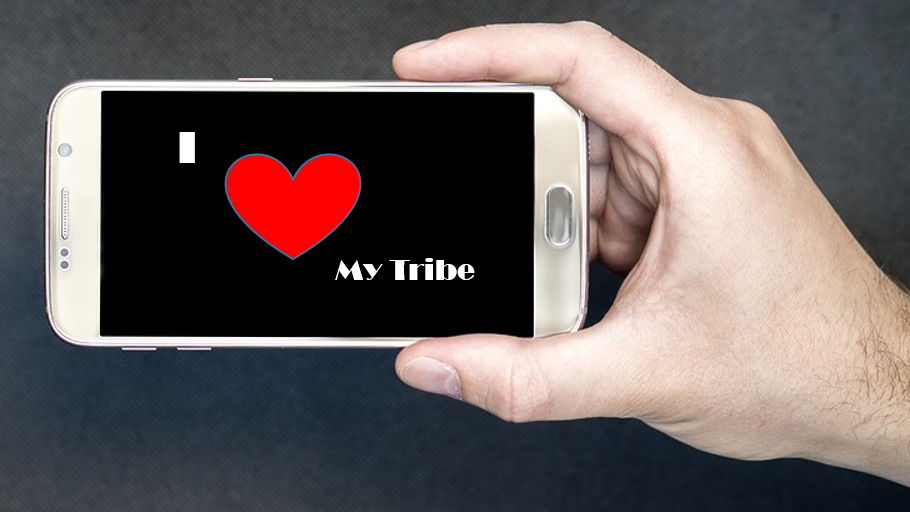
#reviewandreflect: Tribal Forces–3 Vital Elements in the Creation of Your Tribe

This is TheSchoolHouse302’s monthly #review&reflect, wrapping up our focus on Tribal Forces–3 Vital Elements in the Creation of Your Tribe. Our review and reflect offers readers the opportunity to take a deep dive into our leadership content by taking time to reflect and identify the skills you need, to explore how you can learn those skills, and to connect with industry leaders to follow to gain greater expertise.
Skills I need…
Everyone needs to be a part of a strong, reliable, and productive community. Not only do we need to be a part of one, but we have a deep desire to belong to something terrific that can make a difference and fill us with purpose and meaning. The question is, does your tribe, those you associate with both personally and professionally, make you a better and more effective individual?
Review: There are three vital elements associated with harnessing people and leveraging the power of what we call Tribal Forces.
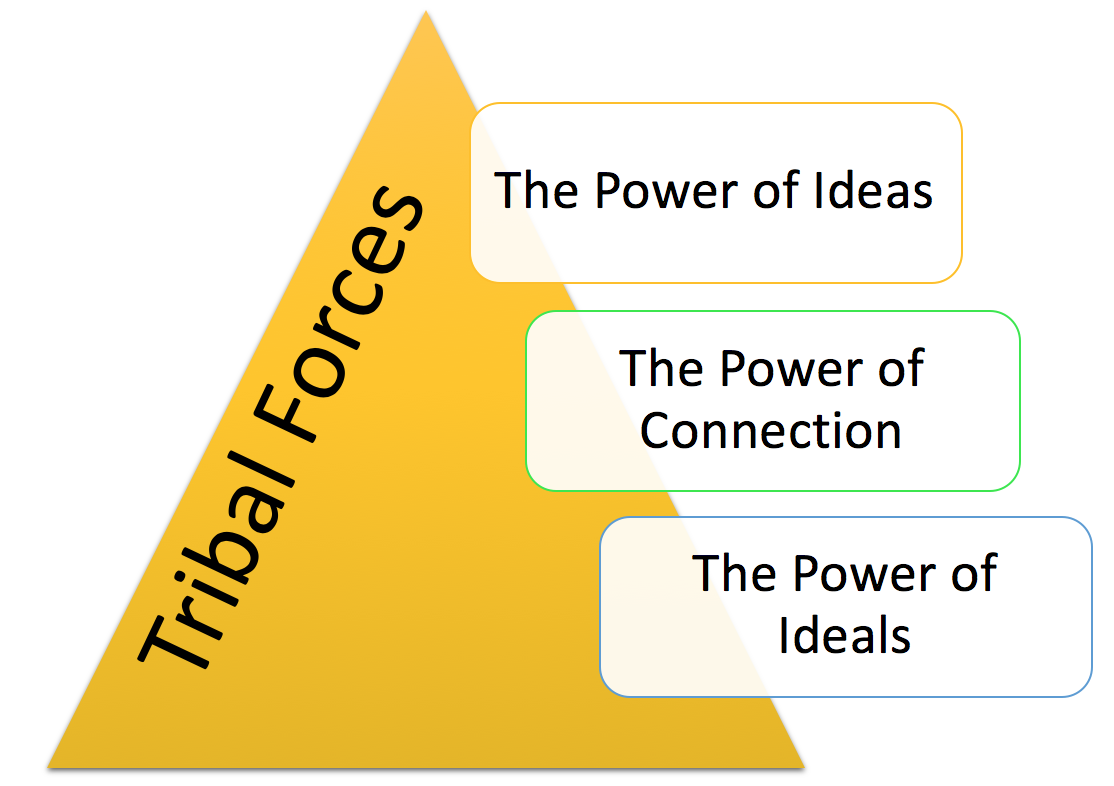
Each part of the model represents a key aspect of a productive and powerful tribe. The first, The Power of Ideas, recognizes that we live in an age of excessive information; however, filtering and gleaning key ideas from multiple sources can generate momentum and lead to growth. The second, The Power of Connection, identifies our need for socialization and community. Leveraged correctly, strong relationships lead to a high degree of synergy and reinforces our overall purpose. The third, The Power of Ideals, is our guiding light, which ensures that our work stays on course and that we are directed by our core values. Together, all three create a powerful trifecta that can mobilize any team by creating powerful relationships that yield tremendous results.
We also acknowledged, though, that there are tribal traps that can thwart any leaders best intentions. These traps, or leadership flaws, can surface at any time and are the exact opposite characteristics and qualities that create a powerful tribe:
Tribal Forces versus Leadership Flaws:
- Ideas and open-communication versus isolation and lack of transparency.
- Connection and relationships versus rules and over-bearing policies.
- Values and beliefs versus rationality and a bottom line.
Reflect: The beauty of the Tribal Forces Model is that it leverages what is most important to people and the qualities that are advantageous for organizations. People don’t work well together when they feel disconnected. And, no one can move forward when the guideposts aren’t clear on the road ahead. The good news is that leaders can decide today to embrace them and make a difference in themselves and the community they create.
Take 3 Minutes to reflect on your ability to create a strong tribe.
- How does your team currently share ideas and problem solve?
- What actions do you need to take to create a stronger connection among your team members?
- What distinguishes your team and your organization from others?
How do I learn those skills…
What should I read to create stronger Tribal Forces in life?
Review: In our #readthisseries we featured the work of authors who clearly articulate the power of tribes through practical strategies and tools that anyone can adopt:
SmartTribes: How teams become brilliant together by Christine Comaford
Fish: A proven way to boost morale and improve results by Stephen Lundin, Harry Paul, and John Christensen
Born to run: A hidden tribe, superathletes, and the greatest race the world has never seen by Christopher McDougall
You can’t miss our #readthisseries on 3 books you need to read for a stronger tribe.
Self Assessment:
Effective and productive leaders recognize the power of ideas, connection, and ideals. Based on the 3-part assessment, and using a 5-point scale, 1 being ineffective and 5 being highly effective, rate yourself:
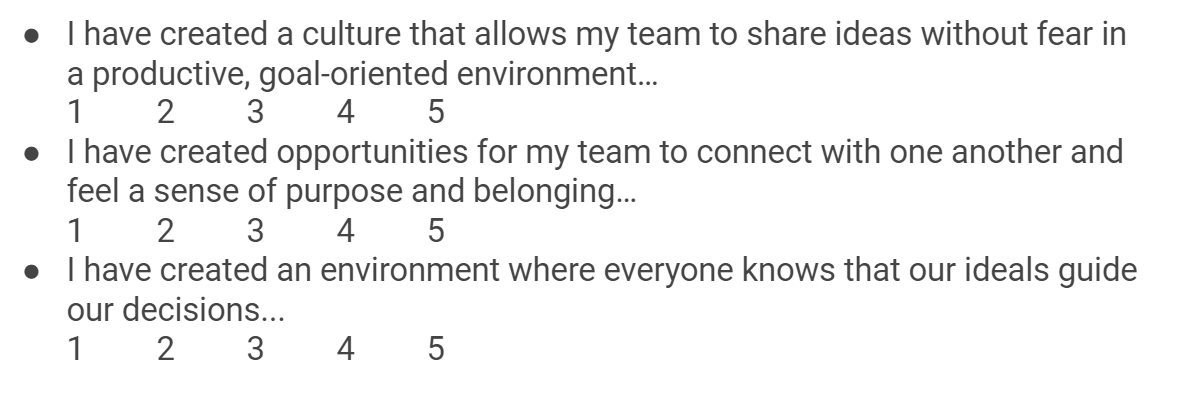
Based on the questions above, which aspect of the Tribal Forces Model do you need to develop further?
Who should I follow…
What does an expert have to say about tribes, optimal performance, and compassionate leadership?
Review: For our #onethingseries, we interviewed Christine Comaford. Christine is the author of three bestselling business books: Power Your Tribe: Create Resilient Teams in Turbulent Times, SmartTribes: How Teams Become Brilliant Together, and Rules for Renegades.
Action: Christine identifies three critical areas that we are constantly craving as humans–Safety, Belonging, and Mattering. She breaks down these areas, including the 10 powerful questions you can ask to assess your own environment so that people are functioning at an optimal level. The question is, what can you do to ensure that your team feels safe, has a sense of belonging, and know that they matter?
Let us know!
Listen to the entire podcast on iTunes, One Thing Series, and please rate and like (it helps).
That’s our #review&reflect for Tribal Forces–3 Vital Elements in the Creation of Your Tribe. Take a look back to take a step forward.
TheSchoolHouse302 is about getting to simple and maximizing effective research-based strategies that empower individuals to lead better and grow faster.
Please let us know how our leadership posts are working for you, what you are reading to improve yourself, and your thoughts on leadership and growth here on our blog and Twitter. Follow our #onethingseries podcast on iTunes and our #readthisseries on YouTube.

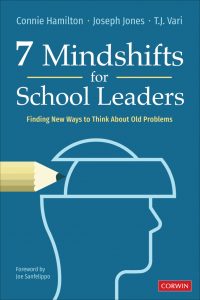 7 Mindshifts for School Leaders: Finding New Ways to Think About Old Problems.
7 Mindshifts for School Leaders: Finding New Ways to Think About Old Problems. 


